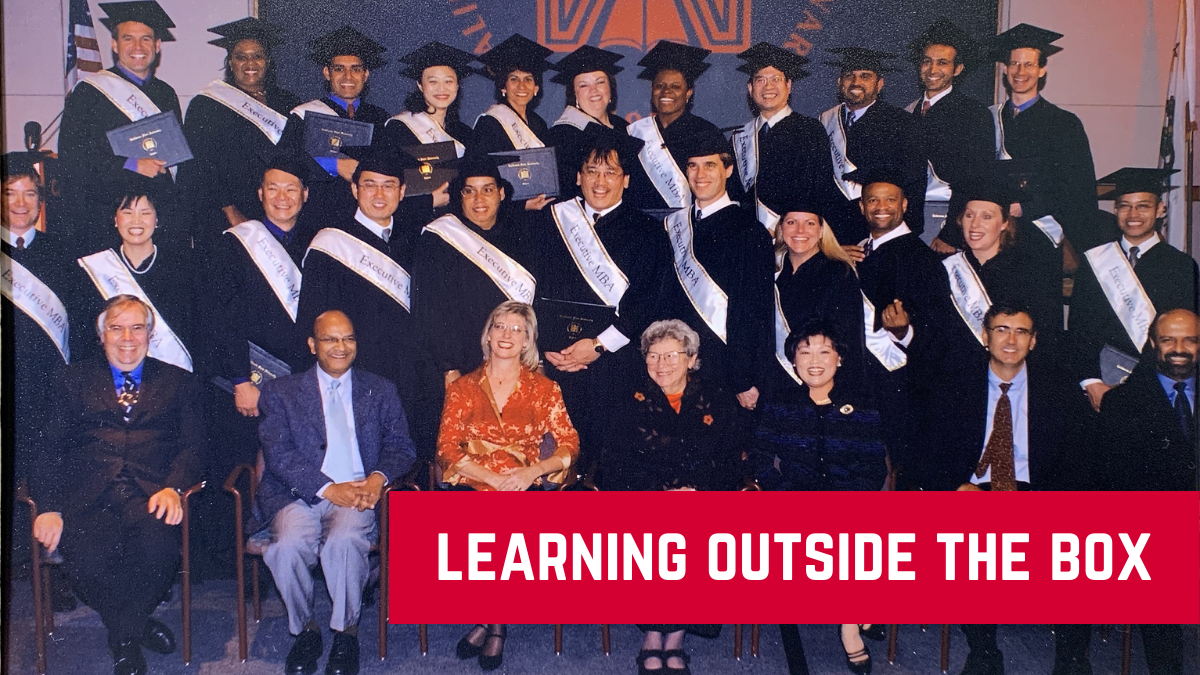
Jagdish Agrawal, former Dean of the College of Business and Economics on the Innovative Transnational Executive MBA Program (TEMBA)
[Photo: Jagdish Agrawal (seated second from the left) with TEMBA faculty, staff and graduates]
The Transnational Executive MBA Program was of great importance to the College of Business and Economics. It attracted top students, brought prestige to the university and produced successful tomorrow-makers in the early 2000s. The TEMBA program taught nine cohorts and over 150 graduates from 2001-2006. During the 13-month program each year, students stayed at the San Ramon Valley Conference Center for four days and three nights out of the month and engaged in experiential training. Projects included solving real-life business problems of companies located in Asia, Europe, and South America. Students and faculty travelled to international destinations to consult with the company management and present the final results of their consulting projects.
Q&A with Jagdish Agrawal
1) You were with Cal State East Bay for over 25 years, can you say the TEMBA program was your favorite? What did you like most about the program?
This was definitely one of my favorite programs because I was involved from the beginning of its creation. I taught in this program. I knew each student of every cohort personally. Along with other faculty and directors of the program, I had the privilege of working as a consultant in their transnational consulting projects and also traveling with them. I was very impressed by the dedication of the leadership, the staff of the program and the faculty who taught in this program. Of course, the participants (students) of this program from every cohort were quite dedicated, willing to stay in the Center every month for four days, away from their families.
2) “Legend” says the TEMBA program was highly acclaimed and sought after. What made the program notable?
The unique feature of the program was the research projects the students worked on as consultants to solve real life problems faced by companies outside the United States. The international companies wanted help to solve their business problems and paid consulting fees to the program for students’ work. In a way, the students of this program were “hired” as consultants to those businesses. Each project was assigned to a group of five to seven students. The students, consulting faculty and staff travelled to the countries where the companies were located. There, they visited their business premises and presented the research proposals defining and refining the scope of the projects.
3) What were examples of projects?
The students worked with companies from countries such as Thailand, Vietnam, Brazil, Chile, and Austria. Most of the projects were feasibility studies related to exporting a variety of products to the US market, ranging from toothbrushes to large tractors. The students had to identify the target market segments in the United States, if any, and design a plan to market those products.
4) How did TEMBA impact students? What stayed with them?
From the very beginning, the students were not only learning about the theories, concepts, and principles of business in each class, but they were actually engaged in solving real-life, challenging business problems. Faculty made sure that the students were able to apply the concepts and tools they were learning in their classes to solve the problems and issues related to their consulting projects. The program followed the concept of “learning by doing.” An opportunity to work with fellow students on a real-life paid consulting project was the leading reason why students chose this program over other competing programs in the Bay Area.
5) Why do you think TEMBA created a special bond among cohorts who remain connected to Cal State East Bay?
I think the TEMBA program was in a sense transformational in the educational experience of the students. Living on campus (San Ramon Valley Conference Center) for three nights, four days every month for 13 months, working in groups to solve live business problems throughout the academic session and travelling together along with staff and consulting faculty to international destinations helped generate a very close bond among the students as well as the faculty and staff. This relationship has continued among many graduates and faculty.
6) CBE recently launched our brand expression - Empowering Tomorrow-Makers but it has been in practice from the very beginning. How have faculty empowered tomorrow-makers?
Dr. Shyam Kamath, emeritus professor of Cal State East Bay, was the architect of this program. He was the Director of TEMBA, primarily responsible for creating and managing this innovative program. He is currently the Dean of the College of Business at CSU Monterey.
And our late Dean, Dr. Jay Tontz, gave his full support to the program.
Many CBE faculty and staff, including emeritus professor Dr. Guido Krickx (who was the co-director of the program and became the dean of the extension programs of San Francisco State University), Kathy Warren (Administrative Director), Donna Booher (Marketing Director) and others were instrumental in the success of this program.
7) Do you have a special message for some of the original tomorrow-makers, your former TEMBA students?
I am very proud of each and every participant of this program. I wish them all the success in their endeavors. I hope they continue to share the fruits of their achievements by supporting the College of Business and Economics and its various student support programs.
We want to hear from you
SHARE YOUR STORY
Do you have a story that demonstrates CBE’s tradition of transformation? Let us know.
SHARE YOUR THANKS
Did a professor, staff member, student or other community member help you finish college or clarify your goals? Share it.